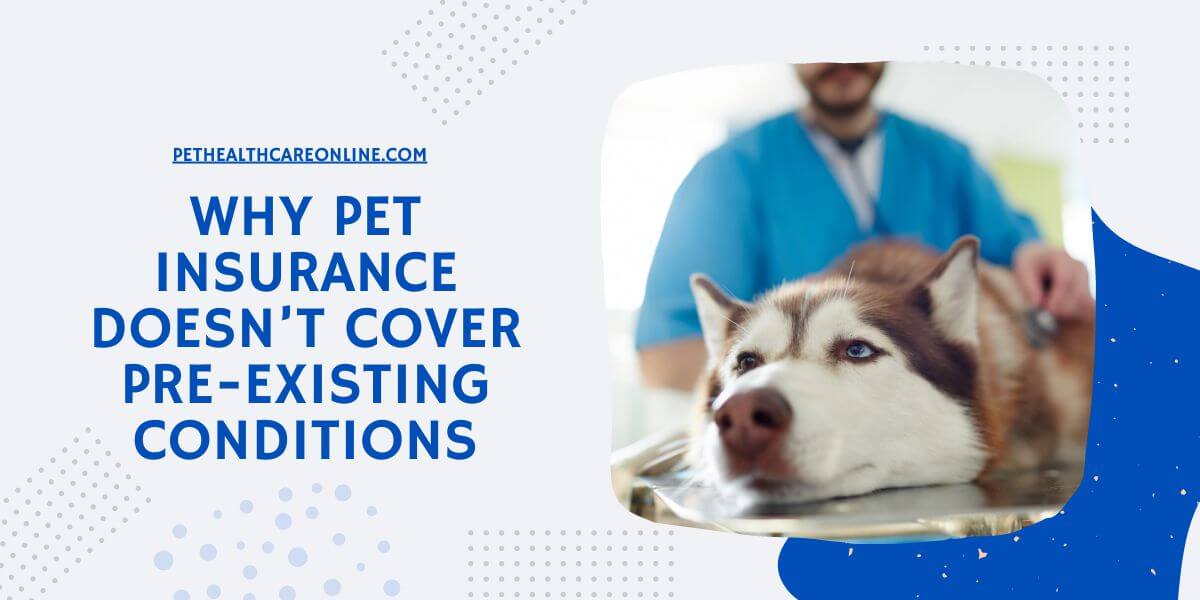Straight Answers!
Financial risk. Pet insurance companies are businesses, and they need to make money. If they covered pre-existing conditions, they would have to pay out more in claims, which would make it difficult for them to stay profitable.
Moral hazard. Moral hazard is the idea that people are more likely to take risks if they know they are insured. For example, if pet insurance companies covered pre-existing conditions, people might be more likely to adopt pets with known health problems, or they might not be as careful about preventing their pets from getting sick or injured.
Lack of data. Pet insurance companies need data to set their premiums and determine their risk. They don’t have as much data on pre-existing conditions as they do on new illnesses and injuries. This makes it difficult for them to price coverage for pre-existing conditions accurately.
Things to keep in mind if you are considering pet insurance:
Enroll your pet early. The sooner you enroll your pet in pet insurance, the less likely they are to have a pre-existing condition.
Be honest about your pet’s medical history. It is important to be honest about your pet’s medical history when you apply for pet insurance. If you lie about your pet’s health, your policy may be void.
Choose a plan that meets your needs. There are many different pet insurance plans available, so it is important to choose one that meets your needs. Consider your budget, your pet’s age and health, and the type of coverage you want.
Introduction
Veterinary expenses are as common as cats breaking stuff, and pet insurance financially helps pet owners when a medical emergency arises. There is a small catch, though – insurance as a concept is structured to help you with a potential future problem – not with something that has already happened. That’s why pet insurance doesn’t cover pre-existing conditions is a rarity.
Chronic conditions require continuous treatment, and for pet insurance companies to offer coverage for ailments that have a reasonable chance of recurrence would be a bad business decision. In the pet insurer lingo, these incidents are known as pre-existing conditions and are typically excluded from the coverage plans.
Most pet insurance providers request a recent veterinary exam before activating the policy. The purpose of the checkup is to identify chronic illnesses the pet may have, in effect raising a red flag for the provider.
The pre-existing condition is not an obstacle in attaining a pet insurance policy, but the coverage will exclude any reimbursements for treatment relating to the chronic illness. Your pet can have an injury resulting in out-of-pocket costs – something you can avoid with pet insurance.
Pet Insurance Pre-Existing Conditions
You may be wondering – what is considered a pre-existing condition? Let us break it down.
For a condition to be classified as pre-existing, your pet must have shown symptoms of the injury or illnesses before the coverage begins. Every insurer has its definition. Owners should carefully check the policy documents and identify what issues the provider considers as pre-existing conditions.
Pet insurance providers discriminate between curable and incurable conditions in their pre-existing pet insurance plans.
Pets are excluded permanently from coverage in cases of incurable conditions, such as:
- Heart disease
- Epilepsy
- Hip dysplasia
- Diabetes
- Cancer
- Allergies
- Kidney disease
- Arthritis
These conditions require daily medication, frequent veterinary visits, and sometimes surgery.
Some pet insurance pre existing conditions are reinstated for coverage if the medical history shows no new symptoms in a given period, usually about a year.
Curable conditions are:
- Respiratory infections
- Gastrointestinal disorders
- Urinary problems
How do Pet Insurance Providers Determine Pre-Existing Conditions?
Policies are not approved blindly. Pet insurance providers request medical records of recent veterinary exams to determine potential symptoms or a diagnosis of a chronic illness before issuing the policy.
Every cat and dog are not anatomically the same as other members of their species. Breeds have distinguishing characteristics that make them more prone to certain diseases or hereditary conditions. Most pet insurance providers will cover breed-specific genetic conditions. However, they will only do it if there are no active symptoms before the start date of the policy.
For example, Siamese cats are genetically prone to develop asthma. Boxers inherit heart-related and thyroid problems, while German Shepherds have a disposition for hip dysplasia.
If you know that your cat’s breed is prone to developing asthma, should you assume it has a pre-existing condition? The short answer is no. Your pet may not display any symptoms at birth or in the first years of its life. In some cases, the condition may not manifest at all. However, that should not stop you from getting a cat insurance pre-existing conditions policy.
Some pet insurance providers exclude certain breeds from full coverage, knowing that the potential for future complications comes along. That’s the same reason why most providers do not allow enrollment of older dogs.
Pet Insurance that Covers Pre-Existing Conditions
There’s a small loophole in the concept of pre-existing conditions that owners can take advantage of if they sign up their pet at an early age. Most chronic ailments manifest in more advanced years. A young pup doesn’t have arthritis, cancer, or heart problems that gives it a clean bill of health at the vet, making it eligible for full coverage.
Some pet insurance providers try to reduce the reimbursement payments by totally excluding certain conditions from their policy. But most reputable pet insurance providers will offer treatments for cancer or heart disease if no symptoms are evident at the start of the policy.
Research is important to learn all the nuances of a policy. That way, owners protect their pet and their bank account from future problems.
The best approach is not to wait for your pet to develop symptoms but to get pet insurance covering pre-existing conditions while young and healthy to escape future struggles with vet bills related to a chronic condition.



